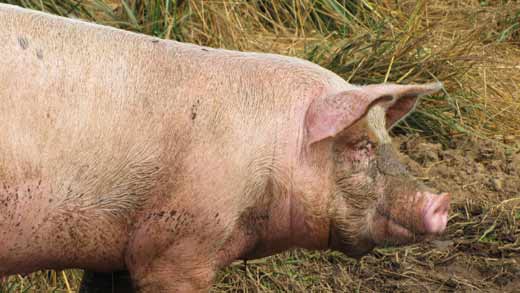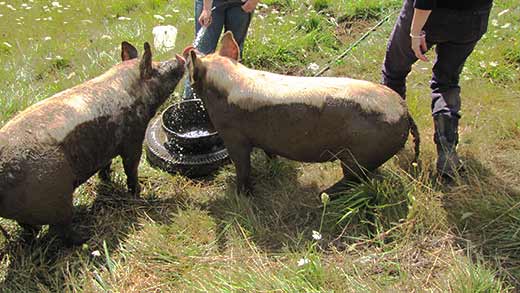As a food writer, and blogger, Kathleen Bauer prefers to write from first-hand experience.
The idea came to her after responding to an offer from a farmer to purchase half a pastured pig.
After agreeing to the purchase from Clare Carver of Big Table Farm, Bauer thought, what if she became involved in the whole farm to plate process while the pig were still alive?

She would tag along with Carver on her farm as she cared-for the two pastured pigs, and help with their care. She also wanted to witness their slaughter, not sure how she might react once a bond had formed with Roger. Afterward, the 300 pound pig would be delivered as a whole carcass to Melinda Casady’s Portland’s Culinary Workshop Studio where Bauer would learn how to efficiently carve up the carcass into recognizable cuts of meat.
The culmination would be a dinner Bauer and her husband hosted for the various parties involved, including Clare Carver, Melinda Casady, the filmmakers (us), other invited guests, and of course, the guest of honor: Roger.
To watch the full Pig to Plate series:
- Pastured Pig to Farm: The Farm
- Pastured Pig to Plate: Butchering the Pig
- Pastured Pig to Plate: The BBQ Pork Roast Celebration
For the finale, Bauer would write about the entire experience on her popular blog, Good Stuff NW.
The “Thinking of Eating” posts she wrote from the project are listed below:

Video Transcript
And help me pick up some pears for the pigs.
Okay.
I wanted to have one of my friend Clare’s pigs. When she gets the pigs, she puts out an email to her list of people who are interested, and she sent one to me. I had wanted one for a long time. I answered immediately, so I got half a pig.
So how big are the pigs now?
I think they’re going to be a little bigger than they usually are. I think they’re going to be close to 300 pounds.
Because I’m a food writer and because I am very interested in finding out more about where my food comes from and what is involved in putting it on my plate, I contacted her and asked her if she would be interested in doing it as a project and letting me come out and visit the pigs and get to know the pigs.
Come on, boy. Here we go. Here we go. Here we go. Good boys. Good boys. Hi.
But then stay through the slaughter and do the butchering and basically cook it and use it and do that as a writing project.
You want another one, huh?
How did you come to name your pig?
Actually, Clare named it. She named both of them after the characters on “Mad Men,” Roger Sterling and Don Draper. This one, this is Roger. If you just stand here and scratch him, he’ll hold perfectly still. He loves that, whereas Don tends to go right for the food bowl. Oh, yeah. You just make every day of their life the best day. And then, you know, they only have one bad day, and that’s, you know, obviously, the day they are slaughtered. And that’s — I think that’s a really wonderful way to look at it, that these are happy pigs. They’re on pasture. They’ve got lots of room. They’ve got each other. And they’re appreciated and treated well.
Doing our best.
Yeah. But yeah, I get kind of choked up when I think about, you know, being here for the kill and the whole after part because, you know, having a relationship with your food is lot more complicated than I thought, you know, than I was anticipating when you’re used to just going to the store and buying the food and getting pieces of things, which I totally appreciate. For me, it’s just more important to kind of know that this is a real creature, that he has feeling, that he’s an individual separate from Don and — that he’s funny and kind of just like a big dog. And I’m going to eat him. I didn’t sleep much the night before. It was — I was thinking about Roger a lot, and you know, this is it. He’s going to be dead tomorrow.
Most of the videos featured on Cooking Up a Story were produced, filmed, and edited by Rebecca Gerendasy. Fred Gerendasy contributed as a writer to many of the posts and occasionally as the interviewer. Visit Rebecca Gerendasy Clay – Art and Fred Gerendasy Photography to see their current work.

